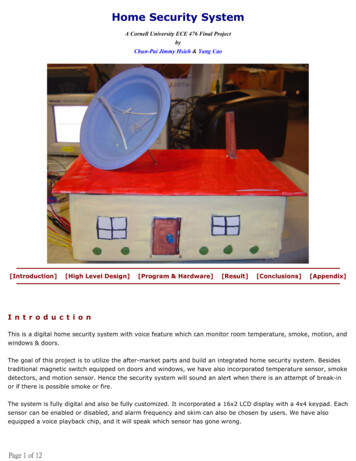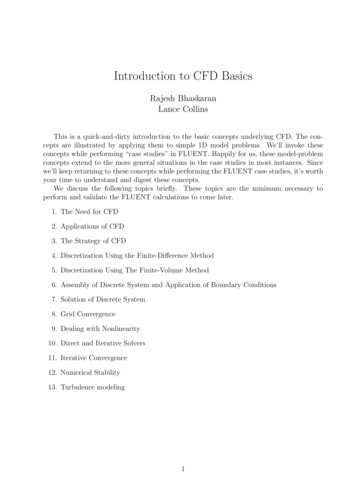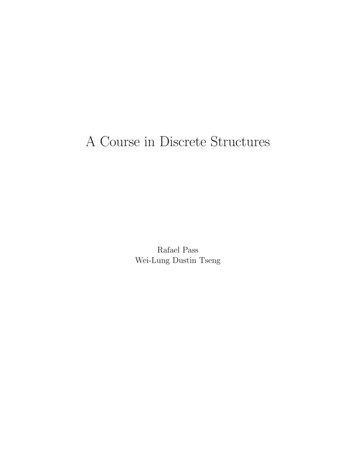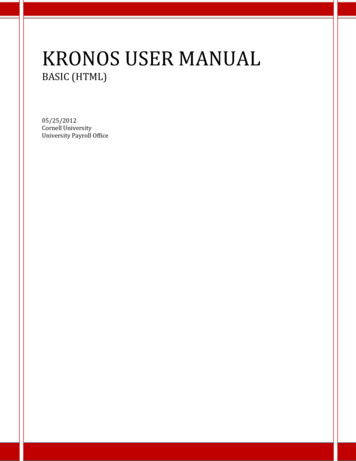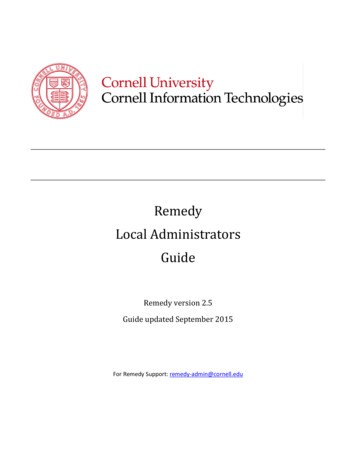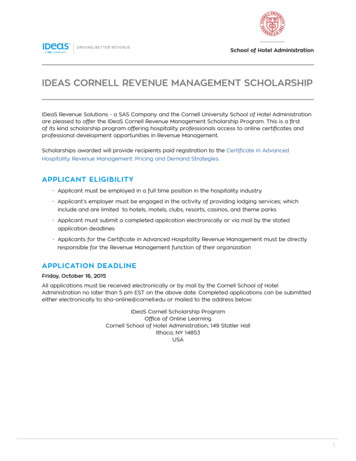
Transcription
Foundations of Data Science Avrim Blum, John Hopcroft, and Ravindran KannanThursday 4th January, 2018 Copyright 2015. All rights reserved1
Contents1 Introduction92 High-Dimensional Space2.1 Introduction . . . . . . . . . . . . . . . . . . . . . . . .2.2 The Law of Large Numbers . . . . . . . . . . . . . . .2.3 The Geometry of High Dimensions . . . . . . . . . . .2.4 Properties of the Unit Ball . . . . . . . . . . . . . . . .2.4.1 Volume of the Unit Ball . . . . . . . . . . . . .2.4.2 Volume Near the Equator . . . . . . . . . . . .2.5 Generating Points Uniformly at Random from a Ball .2.6 Gaussians in High Dimension . . . . . . . . . . . . . .2.7 Random Projection and Johnson-Lindenstrauss Lemma2.8 Separating Gaussians . . . . . . . . . . . . . . . . . . .2.9 Fitting a Spherical Gaussian to Data . . . . . . . . . .2.10 Bibliographic Notes . . . . . . . . . . . . . . . . . . . .2.11 Exercises . . . . . . . . . . . . . . . . . . . . . . . . . .12121215171719222325272931323 Best-Fit Subspaces and Singular Value Decomposition (SVD)3.1 Introduction . . . . . . . . . . . . . . . . . . . . . . . . . . . . . . .3.2 Preliminaries . . . . . . . . . . . . . . . . . . . . . . . . . . . . . .3.3 Singular Vectors . . . . . . . . . . . . . . . . . . . . . . . . . . . . .3.4 Singular Value Decomposition (SVD) . . . . . . . . . . . . . . . . .3.5 Best Rank-k Approximations . . . . . . . . . . . . . . . . . . . . .3.6 Left Singular Vectors . . . . . . . . . . . . . . . . . . . . . . . . . .3.7 Power Method for Singular Value Decomposition . . . . . . . . . . .3.7.1 A Faster Method . . . . . . . . . . . . . . . . . . . . . . . .3.8 Singular Vectors and Eigenvectors . . . . . . . . . . . . . . . . . . .3.9 Applications of Singular Value Decomposition . . . . . . . . . . . .3.9.1 Centering Data . . . . . . . . . . . . . . . . . . . . . . . . .3.9.2 Principal Component Analysis . . . . . . . . . . . . . . . . .3.9.3 Clustering a Mixture of Spherical Gaussians . . . . . . . . .3.9.4 Ranking Documents and Web Pages . . . . . . . . . . . . .3.9.5 An Application of SVD to a Discrete Optimization Problem3.10 Bibliographic Notes . . . . . . . . . . . . . . . . . . . . . . . . . . .3.11 Exercises . . . . . . . . . . . . . . . . . . . . . . . . . . . . . . . . 4 Random Walks and Markov Chains4.1 Stationary Distribution . . . . . . . .4.2 Markov Chain Monte Carlo . . . . .4.2.1 Metropolis-Hasting Algorithm4.2.2 Gibbs Sampling . . . . . . . .4.3 Areas and Volumes . . . . . . . . . .2.
4.4Convergence of Random Walks on Undirected Graphs . . . . .4.4.1 Using Normalized Conductance to Prove Convergence .4.5 Electrical Networks and Random Walks . . . . . . . . . . . . .4.6 Random Walks on Undirected Graphs with Unit Edge Weights4.7 Random Walks in Euclidean Space . . . . . . . . . . . . . . .4.8 The Web as a Markov Chain . . . . . . . . . . . . . . . . . . .4.9 Bibliographic Notes . . . . . . . . . . . . . . . . . . . . . . . .4.10 Exercises . . . . . . . . . . . . . . . . . . . . . . . . . . . . . .5 Machine Learning5.1 Introduction . . . . . . . . . . . . . . . . . . . . . . . .5.2 The Perceptron algorithm . . . . . . . . . . . . . . . .5.3 Kernel Functions . . . . . . . . . . . . . . . . . . . . .5.4 Generalizing to New Data . . . . . . . . . . . . . . . .5.5 Overfitting and Uniform Convergence . . . . . . . . . .5.6 Illustrative Examples and Occam’s Razor . . . . . . . .5.6.1 Learning Disjunctions . . . . . . . . . . . . . .5.6.2 Occam’s Razor . . . . . . . . . . . . . . . . . .5.6.3 Application: Learning Decision Trees . . . . . .5.7 Regularization: Penalizing Complexity . . . . . . . . .5.8 Online Learning . . . . . . . . . . . . . . . . . . . . . .5.8.1 An Example: Learning Disjunctions . . . . . . .5.8.2 The Halving Algorithm . . . . . . . . . . . . . .5.8.3 The Perceptron Algorithm . . . . . . . . . . . .5.8.4 Extensions: Inseparable Data and Hinge Loss .5.9 Online to Batch Conversion . . . . . . . . . . . . . . .5.10 Support-Vector Machines . . . . . . . . . . . . . . . . .5.11 VC-Dimension . . . . . . . . . . . . . . . . . . . . . . .5.11.1 Definitions and Key Theorems . . . . . . . . . .5.11.2 Examples: VC-Dimension and Growth Function5.11.3 Proof of Main Theorems . . . . . . . . . . . . .5.11.4 VC-Dimension of Combinations of Concepts . .5.11.5 Other Measures of Complexity . . . . . . . . . .5.12 Strong and Weak Learning - Boosting . . . . . . . . . .5.13 Stochastic Gradient Descent . . . . . . . . . . . . . . .5.14 Combining (Sleeping) Expert Advice . . . . . . . . . .5.15 Deep Learning . . . . . . . . . . . . . . . . . . . . . . .5.15.1 Generative Adversarial Networks (GANs) . . . .5.16 Further Current Directions . . . . . . . . . . . . . . . .5.16.1 Semi-Supervised Learning . . . . . . . . . . . .5.16.2 Active Learning . . . . . . . . . . . . . . . . . .5.16.3 Multi-Task Learning . . . . . . . . . . . . . . .5.17 Bibliographic Notes . . . . . . . . . . . . . . . . . . . 160162164170171171174174175
5.18 Exercises . . . . . . . . . . . . . . . . . . . . . . . . . . . . . . . . . . . . . 1766 Algorithms for Massive Data Problems: Streaming, Sketching, andSampling1816.1 Introduction . . . . . . . . . . . . . . . . . . . . . . . . . . . . . . . . . . . 1816.2 Frequency Moments of Data Streams . . . . . . . . . . . . . . . . . . . . . 1826.2.1 Number of Distinct Elements in a Data Stream . . . . . . . . . . . 1836.2.2 Number of Occurrences of a Given Element. . . . . . . . . . . . . . 1866.2.3 Frequent Elements . . . . . . . . . . . . . . . . . . . . . . . . . . . 1876.2.4 The Second Moment . . . . . . . . . . . . . . . . . . . . . . . . . . 1896.3 Matrix Algorithms using Sampling . . . . . . . . . . . . . . . . . . . . . . 1926.3.1 Matrix Multiplication using Sampling . . . . . . . . . . . . . . . . . 1936.3.2 Implementing Length Squared Sampling in Two Passes . . . . . . . 1976.3.3 Sketch of a Large Matrix . . . . . . . . . . . . . . . . . . . . . . . . 1976.4 Sketches of Documents . . . . . . . . . . . . . . . . . . . . . . . . . . . . . 2016.5 Bibliographic Notes . . . . . . . . . . . . . . . . . . . . . . . . . . . . . . . 2036.6 Exercises . . . . . . . . . . . . . . . . . . . . . . . . . . . . . . . . . . . . . 2047 Clustering7.1 Introduction . . . . . . . . . . . . . . . . . . . . . . . . . .7.1.1 Preliminaries . . . . . . . . . . . . . . . . . . . . .7.1.2 Two General Assumptions on the Form of Clusters7.1.3 Spectral Clustering . . . . . . . . . . . . . . . . . .7.2 k-Means Clustering . . . . . . . . . . . . . . . . . . . . . .7.2.1 A Maximum-Likelihood Motivation . . . . . . . . .7.2.2 Structural Properties of the k-Means Objective . .7.2.3 Lloyd’s Algorithm . . . . . . . . . . . . . . . . . . .7.2.4 Ward’s Algorithm . . . . . . . . . . . . . . . . . . .7.2.5 k-Means Clustering on the Line . . . . . . . . . . .7.3 k-Center Clustering . . . . . . . . . . . . . . . . . . . . . .7.4 Finding Low-Error Clusterings . . . . . . . . . . . . . . . .7.5 Spectral Clustering . . . . . . . . . . . . . . . . . . . . . .7.5.1 Why Project? . . . . . . . . . . . . . . . . . . . . .7.5.2 The Algorithm . . . . . . . . . . . . . . . . . . . .7.5.3 Means Separated by Ω(1) Standard Deviations . . .7.5.4 Laplacians . . . . . . . . . . . . . . . . . . . . . . .7.5.5 Local spectral clustering . . . . . . . . . . . . . . .7.6 Approximation Stability . . . . . . . . . . . . . . . . . . .7.6.1 The Conceptual Idea . . . . . . . . . . . . . . . . .7.6.2 Making this Formal . . . . . . . . . . . . . . . . . .7.6.3 Algorithm and Analysis . . . . . . . . . . . . . . .7.7 High-Density Clusters . . . . . . . . . . . . . . . . . . . .7.7.1 Single Linkage . . . . . . . . . . . . . . . . . . . . 8219221221224224224225227227
.2282282292302332362392408 Random Graphs8.1 The G(n, p) Model . . . . . . . . . . . . . . . . . . . . . . . . . . .8.1.1 Degree Distribution . . . . . . . . . . . . . . . . . . . . . . .8.1.2 Existence of Triangles in G(n, d/n) . . . . . . . . . . . . . .8.2 Phase Transitions . . . . . . . . . . . . . . . . . . . . . . . . . . . .8.3 Giant Component . . . . . . . . . . . . . . . . . . . . . . . . . . . .8.3.1 Existence of a giant component . . . . . . . . . . . . . . . .8.3.2 No other large components . . . . . . . . . . . . . . . . . . .8.3.3 The case of p 1/n . . . . . . . . . . . . . . . . . . . . . . .8.4 Cycles and Full Connectivity . . . . . . . . . . . . . . . . . . . . . .8.4.1 Emergence of Cycles . . . . . . . . . . . . . . . . . . . . . .8.4.2 Full Connectivity . . . . . . . . . . . . . . . . . . . . . . . .8.4.3 Threshold for O(ln n) Diameter . . . . . . . . . . . . . . . .8.5 Phase Transitions for Increasing Properties . . . . . . . . . . . . . .8.6 Branching Processes . . . . . . . . . . . . . . . . . . . . . . . . . .8.7 CNF-SAT . . . . . . . . . . . . . . . . . . . . . . . . . . . . . . . .8.7.1 SAT-solvers in practice . . . . . . . . . . . . . . . . . . . . .8.7.2 Phase Transitions for CNF-SAT . . . . . . . . . . . . . . . .8.8 Nonuniform Models of Random Graphs . . . . . . . . . . . . . . . .8.8.1 Giant Component in Graphs with Given Degree Distribution8.9 Growth Models . . . . . . . . . . . . . . . . . . . . . . . . . . . . .8.9.1 Growth Model Without Preferential Attachment . . . . . . .8.9.2 Growth Model With Preferential Attachment . . . . . . . .8.10 Small World Graphs . . . . . . . . . . . . . . . . . . . . . . . . . .8.11 Bibliographic Notes . . . . . . . . . . . . . . . . . . . . . . . . . . .8.12 Exercises . . . . . . . . . . . . . . . . . . . . . . . . . . . . . . . . 37.147.7.2 Robust Linkage . . . . . . . . . . . . .Kernel Methods . . . . . . . . . . . . . . . . .Recursive Clustering based on Sparse Cuts . .Dense Submatrices and Communities . . . . .Community Finding and Graph Partitioning .Spectral clustering applied to social networks .Bibliographic Notes . . . . . . . . . . . . . . .Exercises . . . . . . . . . . . . . . . . . . . . .9 Topic Models, Nonnegative Matrix Factorization, Hidden Markov Models, and Graphical Models3109.1 Topic Models . . . . . . . . . . . . . . . . . . . . . . . . . . . . . . . . . . 3109.2 An Idealized Model . . . . . . . . . . . . . . . . . . . . . . . . . . . . . . . 3139.3 Nonnegative Matrix Factorization - NMF . . . . . . . . . . . . . . . . . . . 3159.4 NMF with Anchor Terms . . . . . . . . . . . . . . . . . . . . . . . . . . . . 3179.5 Hard and Soft Clustering . . . . . . . . . . . . . . . . . . . . . . . . . . . . 3185
199.209.219.229.23The Latent Dirichlet Allocation Model for TopicThe Dominant Admixture Model . . . . . . . .Formal Assumptions . . . . . . . . . . . . . . .Finding the Term-Topic Matrix . . . . . . . . .Hidden Markov Models . . . . . . . . . . . . . .Graphical Models and Belief Propagation . . . .Bayesian or Belief Networks . . . . . . . . . . .Markov Random Fields . . . . . . . . . . . . . .Factor Graphs . . . . . . . . . . . . . . . . . . .Tree Algorithms . . . . . . . . . . . . . . . . . .Message Passing in General Graphs . . . . . . .Graphs with a Single Cycle . . . . . . . . . . .Belief Update in Networks with a Single Loop .Maximum Weight Matching . . . . . . . . . . .Warning Propagation . . . . . . . . . . . . . . .Correlation Between Variables . . . . . . . . . .Bibliographic Notes . . . . . . . . . . . . . . . .Exercises . . . . . . . . . . . . . . . . . . . . . .Modeling. . . . . . . . . . . . . . . . . . . . . . . . . . . . . . . . . . . . . . . . . . . . . . . . . . . . . . . . . . . . . . . . . . . . . . . . . . . . . . . . . . . . . .10 Other Topics10.1 Ranking and Social Choice . . . . . . . . . . . . . . . . .10.1.1 Randomization . . . . . . . . . . . . . . . . . . .10.1.2 Examples . . . . . . . . . . . . . . . . . . . . . .10.2 Compressed Sensing and Sparse Vectors . . . . . . . . .10.2.1 Unique Reconstruction of a Sparse Vector . . . .10.2.2 Efficiently Finding the Unique Sparse Solution . .10.3 Applications . . . . . . . . . . . . . . . . . . . . . . . . .10.3.1 Biological . . . . . . . . . . . . . . . . . . . . . .10.3.2 Low Rank Matrices . . . . . . . . . . . . . . . . .10.4 An Uncertainty Principle . . . . . . . . . . . . . . . . . .10.4.1 Sparse Vector in Some Coordinate Basis . . . . .10.4.2 A Representation Cannot be Sparse in Both TimeDomains . . . . . . . . . . . . . . . . . . . . . . .10.5 Gradient . . . . . . . . . . . . . . . . . . . . . . . . . . .10.6 Linear Programming . . . . . . . . . . . . . . . . . . . .10.6.1 The
1 Introduction Computer science as an academic discipline began in the 1960’s. Emphasis was on programming languages, compilers, operating systems, and the mathematical theory that

